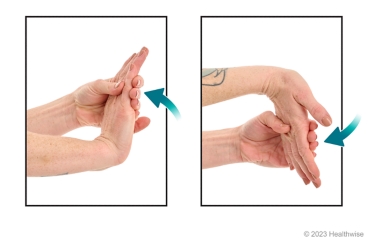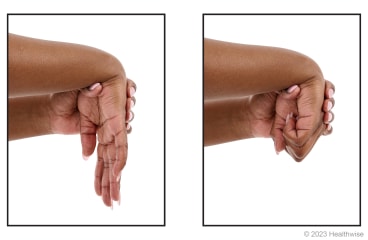Our Health Library information does not replace the advice of a doctor. Please be advised that this information is made available to assist our patients to learn more about their health. Our providers may not see and/or treat all topics found herein.
Wrist Care: Preventing Carpal Tunnel Syndrome
Overview
Anything that puts pressure on the median nerve in the wrist can cause carpal tunnel syndrome. This can include certain health problems and any activities that require repeated, awkward, or forceful wrist or hand movements.
Here are some ways you can help prevent carpal tunnel syndrome:
- Take good care of your health. This can help you prevent or manage health problems that can cause carpal tunnel syndrome.
- Train yourself to use positions or techniques that won't stress your hand or wrist.
- Set up your work and hobby areas to reduce strain on your wrists and hands.
How can you prevent carpal tunnel syndrome?
To help prevent carpal tunnel syndrome:
- Take good care of your general health. This includes staying at a weight that's healthy for you, not smoking, and getting regular exercise.
- Train yourself to use positions or techniques that won't stress your hand or wrist.
- Keep your wrists straight, or only slightly bent, and in line with your arms. Avoid or change activities that bend or twist the wrists for long periods of time.
- Take breaks often, and rest your hands.
- Switch hands and change positions often when you are doing repeated motions.
- Stop any activity that you think may be causing finger, hand, or wrist numbness or pain.
- Set up your work area to be ergonomic. This can include centering your work in front of you and keeping work at the proper height to avoid strain.
Setting up your work area
You can adjust your working environment and how you use it to help prevent carpal tunnel syndrome.
Use the following tips to set up an ergonomically correct workstation. These tips can also help with other work areas, such as where you do your hobbies or work with hand tools.
- Center your work in front of you.
- Check the height of your work.
Your work should be as low as possible without touching your legs (your forearms are parallel to the floor or slightly lowered). If you work while standing, have your work surface at about waist height.
- Keep your hands and wrists in line with your forearms.
For example, if you work at a keyboard, tilt it to help keep this alignment. Use proper hand and wrist position for manual tasks.
- Try a different computer keyboard.
Many people benefit from using a split, V-shaped keyboard. If you can, try one for at least a week. One style may work well for you while another doesn't.
- Hold your elbows close to your sides.
- Avoid leaning on the heel of your hand or your wrist.
- Take little breaks every 10 to 15 minutes.
Use a reminder alarm if you need to.
- Try some stretching exercises.
- Try changing the way you hold a tool.
You may also be able to switch hands now and then when using some tools.
Stretching
These are general stretches for the wrists and arms. Stretching may help prevent some arm problems. Do not do any stretch or movement that is uncomfortable or painful.
Warm-up stretches
- Rotate your wrist up, down, and from side to side. Repeat 4 times.
- Stretch your fingers far apart, relax them, then stretch them again. Repeat 4 times.
- Stretch your thumb by pulling it back gently, holding it, and then releasing it. Repeat 4 times.
How to do the exercises
Prayer stretch

- Put your palms together in front of your chest just below your chin.
- Slowly lower your hands toward your waistline, keeping your hands close to your stomach and your palms together. You will feel a mild to medium stretch under your forearms.
- Hold for at least 15 to 30 seconds.
- Repeat 2 to 4 times.
Wrist flexor stretch

- Extend your affected arm in front of you with your palm facing down.
- Bend back your wrist on your affected arm, pointing your fingers up.
- With your other hand, gently bend your wrist farther until you feel a mild to medium stretch in your forearm.
- Hold for at least 15 to 30 seconds.
- Repeat 2 to 4 times.
- Repeat steps 1 through 5. But this time extend your affected arm in front of you with your palm facing up. Then bend back your wrist, pointing your fingers down.
- It's a good idea to repeat these steps with your other arm.
Wrist extensor stretch (fingers straight or fist)

- Extend the arm with the affected wrist in front of you and point your fingers toward the floor.
- With your other hand, gently bend your wrist farther until you feel a mild to moderate stretch in your forearm.
- Hold the stretch for at least 15 to 30 seconds.
- Repeat 2 to 4 times.
- It's a good idea to repeat these steps with your other wrist.
When you can do this stretch with ease and no pain, try the exercise with your hand in a fist instead of with your fingers pointing down.
Credits
Current as of: July 24, 2025
Author: Ignite Healthwise, LLC Staff
Clinical Review Board
All Ignite Healthwise, LLC education is reviewed by a team that includes physicians, nurses, advanced practitioners, registered dieticians, and other healthcare professionals.
Current as of: July 24, 2025
Author: Ignite Healthwise, LLC Staff
Clinical Review Board
All Ignite Healthwise, LLC education is reviewed by a team that includes physicians, nurses, advanced practitioners, registered dieticians, and other healthcare professionals.
This information does not replace the advice of a doctor. Ignite Healthwise, LLC disclaims any warranty or liability for your use of this information. Your use of this information means that you agree to the Terms of Use and Privacy Policy. Learn how we develop our content.
To learn more about Ignite Healthwise, LLC, visit webmdignite.com.
© 2024-2025 Ignite Healthwise, LLC.





